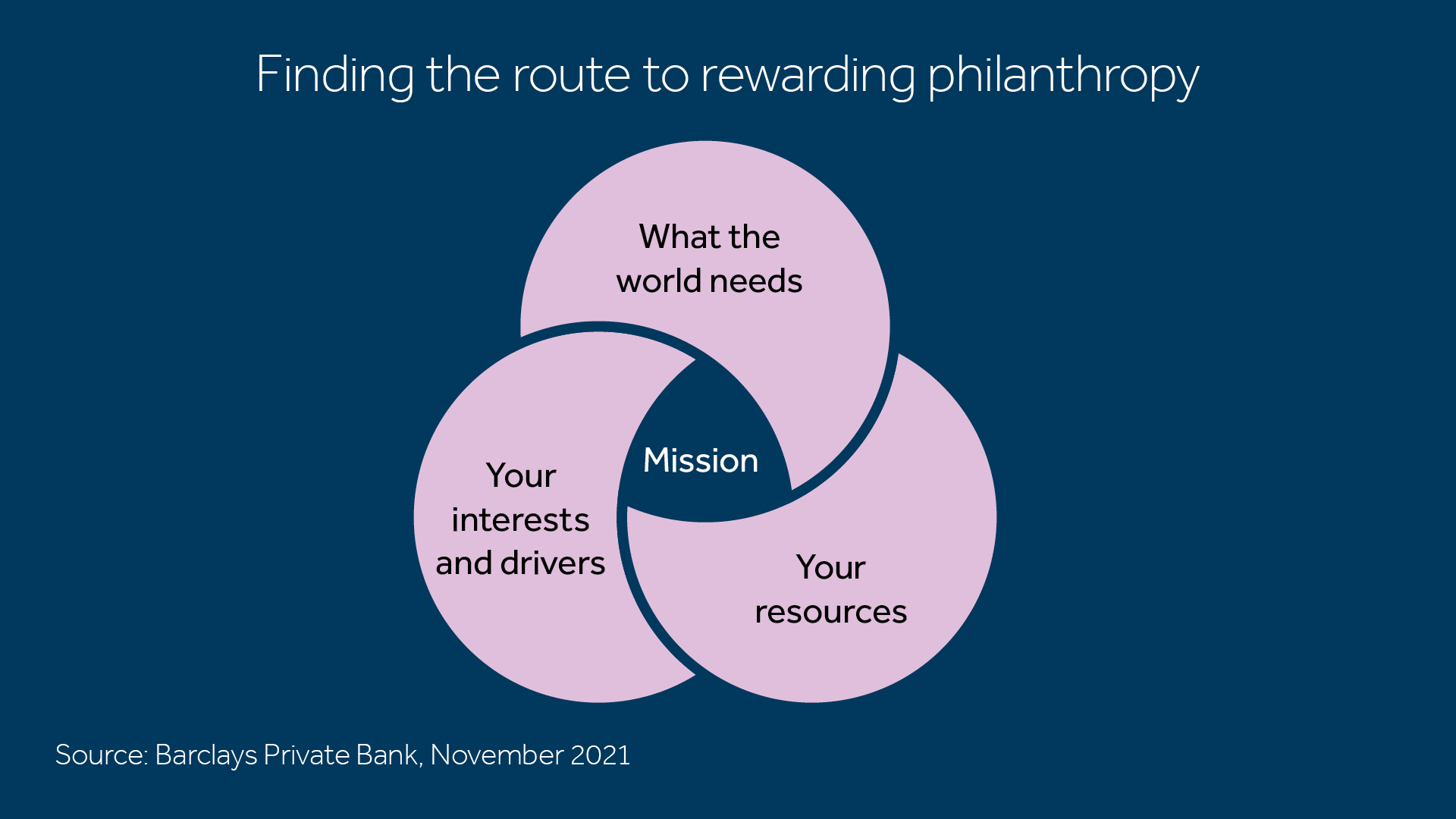
Quashing quarrels: Five philanthropy tips for managing family conflict
06 December 2021
6 minute read
This article is written by Juliet Agnew, our Head of Philanthropy. It’s the last one in a new four-part series exploring the role of philanthropy, the personal experiences of philanthropists, and the evolving global trends that are redefining the act of giving. You can access the other articles at the bottom of the page.
The act of giving should be a joyous process. Philanthropy has the potential to spread joy at scale, but finding the common values to unite a family around a philanthropic vision can be a source of division.
The size of the global philanthropy market is estimated to be US$250 billion. And this figure is rising, with 72% of the world’s 260,000 foundations only being established in the last 25 years1.
With so many new entrants into this world, and the transfer of wealth shifting between generations, a certain level of disagreement is natural, particularly where significant money is concerned. In some cases, a small level of disagreement can also be healthy and helps to sharpen the collective focus.
Philanthropic giving has traditionally focused on the core pillars of society, supporting healthcare, the arts and education – in fact a third of foundations focus on education initiatives2. However, younger generations typically have much broader concerns, with climate change, biodiversity and the transition to a more just and equal society being core focuses for change.

The good news is that with careful and considered handling, these divisions can easily be overcome and their resolution – or rather, the efforts taken to tackle any conflict - may even be a pleasantly surprising unifier. Here are our five tips for keeping a lid on conflict in the giving process:
Tip 1: Find fundamental values that unite
Philanthropy can be deeply personal. It’s rare to find a family where all members are universally passionate about a single cause. To avoid discord, having a series of open and honest conversations about the people, places and problems that you and your family members care about, can help to establish some collective anchors.
And people are united by common values, so it’s worthwhile regularly scheduling time to reiterate what holds you together and to reflect on why these themes are important. Having a long-term, measureable vision of the changes you wish to affect, can be a helpful way to track the progress of your giving. It can also be a trigger for celebration when key milestones are reached.
Finally, remain open-minded to new ideas. The world is changing rapidly, and it’s important to reassess these values regularly to ensure they remain aligned to what you and your family ultimately wish to achieve.
Tip 2: Be honest about your primary objective
There is no single template for how to achieve your philanthropic goals. In fact, the whole field of philanthropy is changing, with some foundations adopting a more ‘venture capitalist’ approach to enabling innovation, addressing market failure, and de-risking new business models.
Such a catalytic style is not for everyone. While some families favour advocacy and seek to influence policy making, others aim to achieve tangible impact on the ground.
Discussing different approaches is therefore an important way of establishing what’s right for your family, and whether it will suit the scale and operational set up of your foundation (if you have one).
Questions to ask include: Do you want to focus on achieving specific results? This will likely require greater focus and some tough trade-offs. Alternatively, will your efforts be primarily geared up to provide a forum for family togetherness? Such an approach will accommodate diverse interests but these may not necessarily be strategically connected.
Remember, there is no single path. And it doesn’t have to be an all-or-nothing approach – some families allocate different funds for different purposes. But being clear about your priorities upfront, and ensuring your philanthropic objectives are well organised from the start, can help avoid misunderstandings further down the line.
Tip 3: Be organised
While philanthropy can often be a passion project for family members, it should be based on more than just good intentions.
Having a clear organisational structure can be a helpful way of working with family members. This can be formal or informal, depending on the nature of your philanthropic goals, but should have a clear process for how decisions will be made and monitored.

Giving family members a say in their involvement can help limit resentment by providing an opportunity for them to determine how involved they wish to be. Positions can range from board membership to being an employee of your foundation (if you have one), or from serving as an informal advisor at family gatherings, to simply making recommendations periodically.
But it is important that roles are assigned appropriately on age, skills, expertise and interest levels and that you recognise where outside expertise may be needed. Care should be taken when engaging with children too, so that they don’t feel coerced and start to resent their philanthropic experiences.
As with many things, it’s often a case of striking the right balance. Being overly inclusive can sometimes cause as many problems as being non-inclusive.
Tip 4: Set clear rules and principles
Having a more professional stance to how your philanthropy is managed can also help limit conflict in the day-to-day running of activities.
We all understand that family conversations often have their own form of shorthand. We know each other intimately which on the one hand can lead to faster decision-making, but on the other hand can mean we know which buttons to push to reignite old quarrels or tensions.
Having a formal set of principles and ground rules for managing conversations enables family members to participate and share their perspectives in a professional manner, as they would in a business setting. It potentially helps avoid falling into familiar family chatter that goes off on a tangent.
This is particularly important if family members do not all have equal decision-making powers, by giving them a forum to express their views and be listened to. It doesn’t mean you have to agree with everyone all of the time, but by at least giving your relatives the chance to be heard, you are more likely to maintain harmony more regularly.
Tip 5: Be willing to teach and to learn
When working in a multi-generational dynamic, it’s important to remember that we can all learn from each other.
While elder family members can model leadership, professionalism, and business acumen for their younger relatives, the situation is often reversed when it comes to harnessing new technology, being social media savvy, and understanding trends and issues from the younger generations’ perspectives.
The knowledge that each family member has something positive to contribute can be an effective tool in ensuring that everyone feels involved and respected.
Ultimately, treating others as we wish to be treated, is the best way of keeping tempers cool and ensuring fruitful communication.
Strengthening family bonds through philanthropy
All families are different. This means there is no one correct way to structure family philanthropy.
We can’t promise to eradicate conflict completely, but adopting key principles that seek to inform, value and appreciate each family member can help make your philanthropic journey as rewarding and successful as possible.
Philanthropy is a transformative exercise – not only for the communities or projects you are supporting, but also for uniting your family in a common cause.
Related articles
This communication is general in nature and provided for information/educational purposes only. It does not take into account any specific investment objectives, the financial situation or particular needs of any particular person. It not intended for distribution, publication, or use in any jurisdiction where such distribution, publication, or use would be unlawful, nor is it aimed at any person or entity to whom it would be unlawful for them to access.
This communication has been prepared by Barclays Private Bank (Barclays) and references to Barclays includes any entity within the Barclays group of companies.
The communication is:
- not research nor a product of the Barclays Research department. Any views expressed in these materials may differ from those of the Barclays Research department. All opinions and estimates are given as of the date of the materials and are subject to change. Barclays is not obliged to inform recipients of these materials of any change to such opinions or estimates;
- not an offer, an invitation or a recommendation to enter into any product or service and do not constitute a solicitation to buy or sell securities, investment advice or a personal recommendation;
- is confidential and no part may be reproduced, distributed or transmitted without the prior written permission of Barclays; and
- has not been reviewed or approved by any regulatory authority.
Any past or simulated past performance including back-testing, modelling or scenario analysis, or future projections contained in this communication is no indication as to future performance. No representation is made as to the accuracy of the assumptions made in this communication, or completeness of, any modelling, scenario analysis or back-testing. The value of any investment may also fluctuate as a result of market changes.
Where information in this communication has been obtained from third party sources, we believe those sources to be reliable but we do not guarantee the information’s accuracy and you should note that it may be incomplete or condensed.
Neither Barclays nor any of its directors, officers, employees, representatives or agents, accepts any liability whatsoever for any direct, indirect or consequential losses (in contract, tort or otherwise) arising from the use of this communication or its contents or reliance on the information contained herein, except to the extent this would be prohibited by law or regulation.